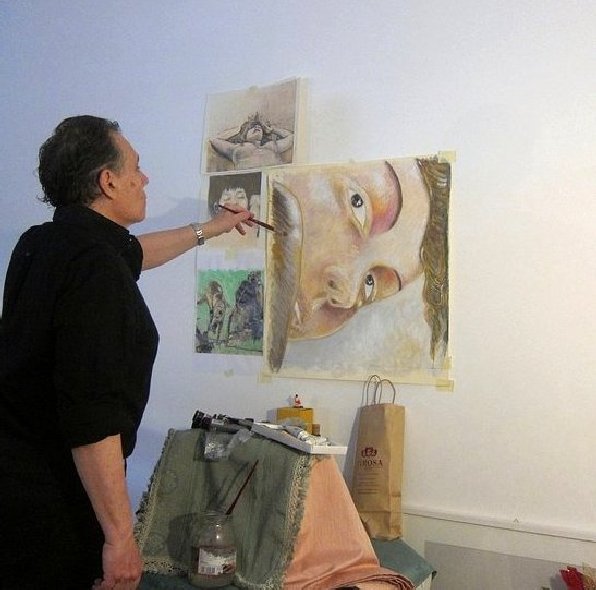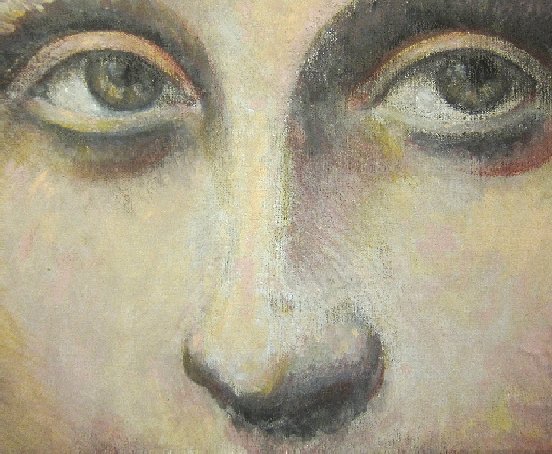“Art, whatever it takes”
The RomeArtProgram has made a series of interviews with Artists living in Italy, the USA & the UK to know their feelings and orientation during these times of emergency.
CarloMoratti is an Italian Artist – Rome – Painter, RAP Faculty member.
-RAP: Where do you live ? And what is your background?
Carlo: I live and work in a central area, used to traffic, people and tourists.
I traveled and lived a lot abroad, after finishing my studies in Rome with a master in Communication.
Alberto Sughi, the great painter, was a friend of my father, who, feeling guilty for not having allowed me to do academic studies, then thought to send me to Alberto for a long and intense period of practicing and learning the techniques of color and composition. Alberto Sughi and Renzo Vespignani were the leading figurative painters, at that time.
Alberto depicted large portraits of intense and profound moments in the lives and relationships of people. The first time I entered his studio, at the Circo Maximum, I remained breathless, by the intensity and the fierce critical sense with which Alberto portrayed people of the wealthy upper bourgeoisie whilst they gorged on eating and chatting, with a brutal cut reminiscent of Caravaggio’s images.
Then, I studied at NY Studio School: a crucial & determining experience in my development as an artist. Graham Nickson would come into the studio unexpectedly, whilst I was at work, giving valuable suggestions with his elegant touch and ability to synthesize problems and solutions. Unforgettable. The NYSS’ competitive spirit and critique sessions were a tough challenge.
The RomeArtProgram was another creative milestone, another challenge for experimentation and working from synthesis, while practicing plein air painting among monuments, museums and galleries. Those sources of inspiration that can magically provide the right path, thanks to Carole Robb’s teaching approach and my search for a sense of synthesis in front of universal works of art. And all this at the speed of light.
Last year during the RAP Benefit Show, one of my paintings was bought by the NY art critic David Cohen (Art Critical) and that was such an emotional experience and also a big surprise
– In your opinion is there a “creative method”?
Working during the night, for many authors, can be the time of the most intense concentration and this can facilitate intuition and experimentation. Every work is an experiment, painting evolves through continual changes which reflect particular moments, while watching the theatre of every day life and finally getting to what we want. “Nothing is in the intellect that was not first in the senses” Thomas d’Aquino said. In addition, there are the infinite sources of inspiration and creativity that are possible, even easily, to be found in Rome.
– The “lock down moment” in emergency times can set you on the path of some important change(s) in your creativity and style…Has this happened to you?
Time and silence were a big issue, how liquid days were. I would go out every day and walk miles in an empty surreal city. I would have gone mad staying home all the time. I was making drawings and time and silence were evoking the cities of de Chirico and Carrà. Indifference and dodging were dominant everywhere, as in the “impossible worlds of Escher”, each person changed his gaze and direction by crossing, wrapped by panic and anxiety, disbelief entered everywhere, so easy to lose heart. The goal was to overcome the moment of emergency.
– What normally inspires you? Which is the most important inspirational source you have found in Rome?
Growing up in the city, I was impressed by the figures of gladiators, they were the real “superstars”, because in ancient Rome actors and actresses used masks, according to the Greek tradition, so they were not famous.
We all used to play with these models, for that’s essential in immersing yourself in the process.
Then I shifted into common people, their expressions, their moods and how to freeze moments; those inspirational moments that occur during the normal life, when something “extraordinary” happens. So, i.e. you see the boy bitten by a lizard, by Caravaggio… that image is like a modern snapshot taken by an hitech camera; he used the light as a razor in the darkness!
Roman sculptures, with slaves, emperors, deities, are like an historical parade. The dying Galata (dying Gaul)-Roman Museum Altemps- is another excellent frame of condensed history.
– Is there a difference in working in Rome for an artist? What art medium do you prefer to work in?
Creative work grows better in rich cultural environments; let’s think about the Renassance and Baroque: it was an explosion, an apotheosis of Art, duels of ingeniousness, such as Michelangelo and Raphael, Bernini and Borromini…
I don’t have a preferred medium. I think that it’s important to confront yourself with movements and artists from other places; Rome gives you the privilege of an incredible system of Academies where you can compare yourself and talk with artists from all over the world, starting with the Accademia di San Luca, the first ever in the history of art.
– Specific events and historical conditions have a significant role in the creative process; how does this pandemic emergency affect the Arts?
Art and Culture were penalized hard and everyone is having a challenging time right now. Rome was and is empty, Museums and Galleries have to face difficulties, and the Rome Art Program was suspended in order to avoid risks to students and artists, all blocked. “Darkness” started dominating places and people, and of course creativity. I showed in a group-show just a couple of days before the lock-down; the Gallery has now reopened. This was the last opening in Rome before lockdown. At least artists were able to go on working at home, draw or paint.
In the past Art was often committed to representing battles and wars. Today it’s focusing on this emergency; while public art projects disappeared, exhibitions are now slowly reopening; the emergency is flattening art-making and buying trends, and the “cultural industry”.
– How are you feeling at this difficult moment and what made you feel this way? …are you optimistic for the future?
It is always advisable to be optimistic, because it brings the desired result closer.
Pessimistic people?.. they suffer twice. During the peak of the emergency, with thousands of victims and a total uncertainty, it was almost impossible not to be optimistic, in order to be able to move forward among thousands of difficulties and fears. Every person crossing you could be an enemy. Now things are getting better, some people are doing great things, and that gives hope.
– What can Art contribute to history? Will “Art save us” ?
Art makes us dream, and without dreams there is no life. Art is the mirror and the storytelling; can you imagine “history” without Art?
– What is your most ambitious dream?…and the greatest sacrifice that you have made for your Art?
I started working on a new series, before the emergency; it’s something quite ambitious.
Sacrifices? ..surviving the pressure of studying at the NY Studio School and it’s critique sessions lasting so late, that going back home on foot, crossing Washington Square with the squirrels and on to Broadway and Canal St., I was so tired that I never noticed the risks -and the Police- around. Half of what we get is due to luck, the other half to how we’re able to attract it. Graham Nickson used to say “be brave ..!”
– Recently, the artistic and cultural message of Italy and Rome was that it was re-emerging as a great “work in progress”…is this your point of view?
Rome itself is one of the greatest works of art in the world, but at the same time it’s like a sleepy Cinderella, surviving everything unconsciously; while there were ongoing pointless & pretentious public projects ruled by political interests Only a few were any good.
Art in Rome is mostly a “window”, adapting to modern tendencies (and resisting some) while respecting the past, a dichotomy. It always has been a “work in progress”: a crucial mix of the past and the present. It’s still central to Art.
– Which is your favorite Italian, or Roman, place(s) of art (Museum, Gallery, Monument…)?
The Eternal City is like a huge prismatic artwork: The Galleria Borghese, Galleria Barberini Corsini, Vatican Museums, St.Peter’s Basilica, National Gallery of Modern and Contemporary Art, Trevi Fountain, Navona Square, Colosseum and Forum, hundreds of spectacular Churches, and the Pantheon: an architectural project which has a big hole in it’s roof, revolutionary, “Dadaistic”, and on Raphael’s tomb is written “Here lies Raphael by whom Nature feared to be conquered while he lived, and when he was dying, feared herself to die”. Live and learn… we cannot leave Rome without seeing the stunning and vibrant Caravaggio’s paintings -an encyclopedia in itself- ; the Warhol’s double portrait at the marvellous Bilotti “boutique” Museum -probably the only “double portrait” he ever made- one of the most amazing modern artworks I have ever seen.
– Which period of Italian Art do you prefer? What is your favorite Italian work of Art?
More than one… Raphael and Caravaggio, the piety of Michelangelo, the Sistine chapel, the Ecstasy of saint Teresa by Bernini and his works at the Borghese Gallery, the spectacular Pietro da Cortona’s fresco at Palazzo Pamphilj, the Brazilian Embassy.
– How has Rome personally influenced you as an artist and a person?
The influence of Art in Rome is dominant, vibrant, ever-present, it seems to be like an imprinting that has become even stronger with the RomeArtProgram. Rome, it’s always with me, even when I don’t want it, because it makes the challenge harder.
– What’s your goal? What role does the artist have in society? Any final thoughts and advice?
To evolve.
.
Reference Art Gallery: Spazio40galleria.it – #spazio40galleria – Rome
The RomeArtProgram is ready to bounce back!
_____________________
RomeArtProgram
Art-as-Power
#romeartprogram


